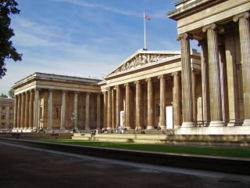
The British Museum in London, UK
New Galleries at the British Museum
Opens 13 June 2007
]]>
In June 2007 the British Museum will open three newly refurbished galleries devoted to Ancient Iran, Prehistoric Europe and the Middle East. Vital plant works and refurbishment have also taken place in the galleries of Iron Age and Roman Britain. The galleries are situated on the upper floor of the Museum and are the first to reopen as part of an ongoing plan of gallery improvement.
Room 52: The Rahim Irvani Gallery of Ancient Iran
This gallery features objects from the Museum’s unparalleled collection of material from Ancient Iran. Cases examine the birth of the first cities, the age of migration, the development of the Persian Empire, the Iranian revival under the Parthians and the Sasanian empire which followed. The iconic Cyrus Cylinder and the extraordinary Oxus Treasure form the centrepiece to the gallery, testimony to Iran’s importance in the ancient world. Early casts of relief’s from Persepolis, the capital of the Persian Empire, are mounted on the gallery walls to suggest the monumental splendour and power of the Persian state. These relief’s also bear witness to the extent and size of the empire, featuring subject peoples from as far afield as India and Greece bearing tribute for the Persian king. Audio visual screens give visitors an opportunity to examine the site of Persepolis in depth offering a reconstruction of the site at its zenith and of its destruction by the troops of Alexander in 330BC. The new gallery has been generously supported by Maryam and Vahid Alaghband
Room 51: The Birth of Agriculture; Europe and the Middle East 10,000-800 BC
In this space the ancient Middle East meets ancient Europe. Both stories begin here, with the birth of agriculture 12,000 years ago in the Middle East, when in Europe people were still living off the wild resources the land provided. The switch to food production was to change their way of life for ever. People settled down in villages and towns developed and trading networks were consolidated and expanded. This new way of life spread gradually across the Middle East and Europe, arriving in Britain about 6,000 years ago. The gallery displays artefacts which are the only evidence we have of how people lived in this period. These are nonetheless full of clues to the ways in which they positioned themselves in society, in the natural world and in the cosmos. The gallery will feature the oldest known grinding stone in the world, which is 12,000 years old and comes from Abu Hureyra in Syria. Such stones were used to produce flour from grains and pulses such wheat and lentils. The figures moving in a ritual dance on the sophisticated bowl from Tall-i-Bakun, southern Iran contrasts with the mysterious spirituality of the shaman’s headdress from Star Carr in Yorkshire made during the same period.
Room 51: Prehistoric Europe
Once farming was established in Europe, it took some 3000 years to reach Britain at around 4000BC. Agricultural communities left a heavier footprint on the land both in terms of the monuments they built and the material goods they lost, concealed or discarded. The gallery features some of the most important prehistoric objects in the Museum’s collections. Through them we may track the ways in which these goods were deployed to define identity, wealth, power and status in an increasingly competitive world. Such concepts were evidently as important in death as in life, in matters mundane and sacred. This is borne out by objects as diverse as the unique Mold gold cape, the stunning Ringlemere cup and the enigmatic Oxborough dirk. Everywhere in Europe regional identity was strongly expressed, whether through striking personal ornaments, distinctive battle gear or the potter’s art. Ornate equipment like the Dunaverney bronze flesh hook bears witness to the social and political importance of feasting. Vigorous, diverse and enduring cultures had developed in Britain and Europe well in advance of the Roman Empire, exploding the myth that the Romans were the first to ‘civilise’ the region. The objects on display in the gallery also show how new ideas were taken up, adopted and adapted by different prehistoric communities. Britain’s iconic monument, Stonehenge, looks over the gallery in two guises: bleakly, in Winter, on the west wall and at Midsummer sunrise on the east, reminding us of the sun’s journey through the cosmos, the human journey through life into death and the supremacy of the annual cycle which is the farming year.
Room 49 The Weston Gallery of Roman Britain
Thanks to the generosity of the Garfield Weston Foundation the Museum has been able to undertake vital improvements to the infrastructure of one of its most popular galleries. Containing thousands of objects dating between AD43 and AD 411, it includes examples of masterpieces of Romano British silverware and the famous Vindolanda tablets. Some of the key treasures from the museum’s British collections including the Mildenhall Treasure, the Hoxne Hoard and the Walter Newton Treasure have been conserved and re-displayed to include more contextual information. Part of the Hinton St Mary mosaic, possibly the earliest depiction of Christ will form the centrepiece to the gallery. New finds such as the extraordinary Ashwell Hoard (purchased with the help of the Art Fund) will go on display for the first time after extensive conservation work.
Follow us on:

